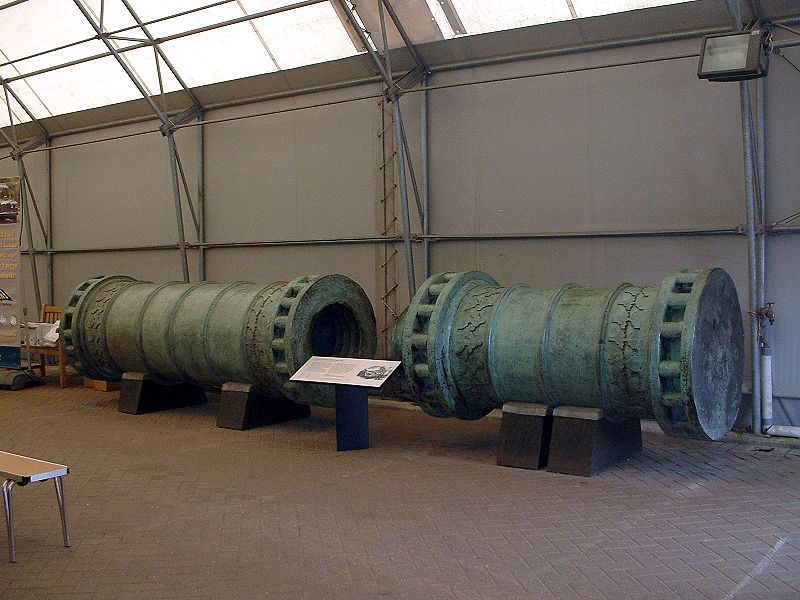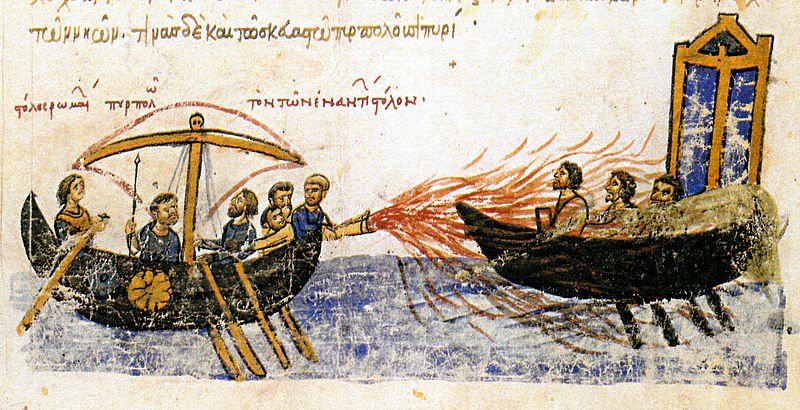A siege weapon or siege engine is a tool designed to try and get through city walls or other fortifications, and defenses. Originaly siege weapons were made mainy out of wood but eventually began to be made with metal and gunpowder. The earliest siege weapons would normally just hurl heavy objects at enemy forts in an attempt to break them down. Siege weapons were brought to a whole new level during the 20th century during World War One and World War Two. This is because as weapons for besieging got better, fortifications were made stronger to defend against this, and so siege weapons had to be made even stronger to destroy the stronger fortifications.

Karl-Gerat 040/041

Karl-Gerat was a World War Two siege mortar. It’s heaviest munition weighed almost 5,000 lb and it’s lightest was over 2,500. It’s shells could fire and hit a target over 6 miles away. It’s one of the biggest and most powerful guns ever created. They made seven of them, six of which saw action. They destroyed the soviet fortresses of Sevastopol, participated in the Battle of the Bulge, attempted to destroy the Ludenforff. In 1944 a Karl-Gerat was ordered to aid in putting down the Warsaw Uprising. The gun proved to be very effective, and they even ordered a second one.

Big Bertha (Howitzer)

Big Bertha is a giant howitzer gun built for the Germans during just before World War One. The sheer size of this gun would already scare and demoralise the enemy, and when it fired this fear would only intensify. Even though it’s heavy and slow, it makes up for that by firing powerful shots over a long range. The gun was named Big Bertha when it destroyed the Fort Loncin with one of it’s shots. The gun was so big only 12 were ever put into service. It could fire objects up to 810 kg in weight, which made it easy to destroy the reinforced concrete of the French, and Belgian forts.

Dardanelles Gun

The Dardanelles gun was the biggest cannon ever built when it was used at the Siege of Constantinople in 1464. It was a large weapon, and slow because it weighed almost 40,000 lb, the equivalent of 6 elephants. It was built specifically to destroy the fortifications of Constantinople, which was believed to be impenetrable. The gun was built by Orban, who originally offered his services to the Byzantines, but they couldn’t afford his high fee. He then went to the Ottomans and offered to build a cannon that could blast the walls of Babylon itself. They gave him all the money and resources he needed. Three months later he had built the cannon, and used sixty oxen to drag it to Constantinople. The cannon was so powerful that once it was shot, it became so hot that they had to wait for it to cool down before firing it again. Siege weapons had never been as strong, or heavy before this.

Trebuchet
The Trebuchet is one of the most famous and successful siege weapons of the middle ages. They were gigantic tools which allowed people to throw large, heavy objects, that ordinarily would be impossible to throw. This siege weapon will throw 90kg projectiles at enemy fortifications up to a distance of 300m, destroying anything it hits. The Crusaders used what they called “great trebuchets” at the second siege of Tyre in 1124. It’s said that the trebuchets could shatter city walls, and the defenders built equipment to try and counter this. The first traction trebuchets were invented by the Chinese before the 4th century BC.

Onager

The Onagers were an ancient Roman siege weapon designed to hurl rocks at enemy forts or settlements. The onagers could be armed with stones covered in a combustible liquid and set alight. The shots were powerful, and could devastate the enemy, but the range wasn’t great, and the onagers could be out ranged by bows. The weapon gets it’s name from the kicking action of the weapon, which is similar to the animal called an onager.

Ballista

The Ballista is a siege weapon used for attacking and defending castles. It fired a giant iron clad arrow at the target, and could take out several people in one shot. Ballistae could also fire heavy stones in siege warfare. The ballista was proved to be a very effective weapon in sieges and battles, and for putting down riots. The ballista was invented by the Greeks in 400BC. The ballista reached Europe during the medieval era and was widely used by French armies.

Helepolis
Helepolis means “Taker of Cities”. Helepolis was a gigantic siege tower. It was 130 ft tall, 65 ft wide, and weighed 160 tons. Siege towers were large rectangular towers, which would be filled with people, and slowly wheeled towards a fortress or castle. The towers often have archers at the top, which allows them to have greater range, and defend the tower from opposing archers as they encroach upon them. Because the tower was flammable, they would cover it in iron or animal flesh to stop it catching on fire. The towers were big enough to allow thousands of people to storm the castle walls and dominate the defending force. The size, and strength of these towers made them one of the most effective siege weapons.

Greek Fire

Greek fire is an amazing type of fire the ancients used that couldn’t be put out by water. It could even stay alight while floating. We still don’t known what the ingredients were, and how they made it immune to water. It was commonly used in naval warfare, as it stayed alight on the water. Greek fire would devastate any fortification made out of wood. In sieges it would likely demoralise the opposing force who saw that water couldn’t put it out. It was invented in the year 672, by Kallinikos. Stone castles were susceptible to fire, because they contained many flammable materials. Intense heat would also cause stone to crack and collapse. Since the most common defense against fire attacks was water or other liquid, Greek fire was almost unstoppable.

Tunnelling
Attacking forces would mine under city walls, a fortress or a castle. The tunnel could then be used to sneak into the city, or to destroy the walls above. The tunnels would be supported by wooden props until they finished the tunnelling. They would fill the tunnel with flammable, or explosive material, and then wait for it to explode. With no support below it the walls would likely collapse. Often the defenders would set up a counter mine, to attack the invading miners.

Schwerer Gustav

This is one of the largest siege weapons ever created, it’s 38 ft high, and 155 ft long. The barrel alone is around 100 ft long. The gun was supposed to be used for the Battle of France, but they couldn’t finish in time, and this behemoth of a weapon ended up seeing very little action. It was supposed to destroy the most important forts of the Maginot Line, which at the time was the strongest fortification in existence. In the end the Germans Blitzkrieg offensive isolated the French and forced them to surrender which rendered them useless. They finally saw action in the Siege of Sevastopol.




